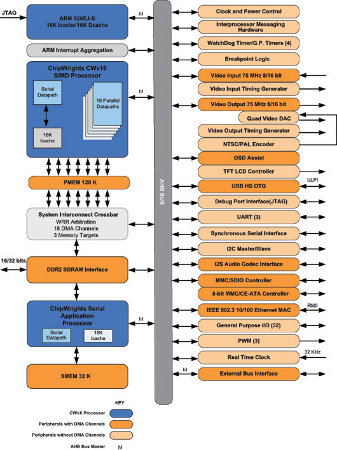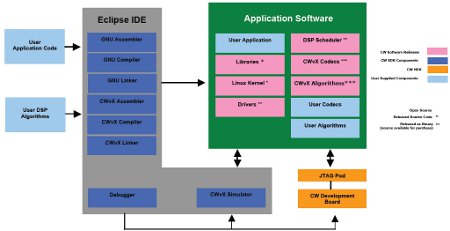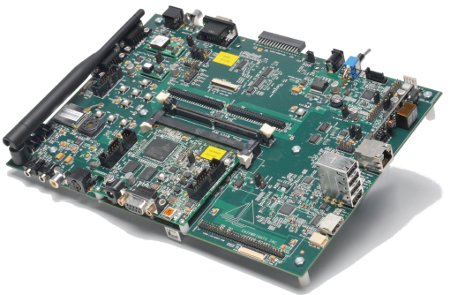Video-focused ARM/DSP SoC gains Linux development kit
Aug 19, 2010 — by Eric Brown — from the LinuxDevices Archive — 17 viewsChipWrights announced a Linux application development kit (ADK) for its CW5631 SoC, aimed at low-cost IPTV STBs and IP cameras. Like ChipWrights' Linux-based CW5631 SDK announced earlier this year, the H264-ready ADK supports the CW5631, which combines a 400MHz ARM9 core, a DSP, and a RISC core.
In February, ChipWrights, which is owned by AD Group, announced a Linux software development kit (SDK) for its video-focused CW5631 system-on-chip (SoC). Like the SDK, the new application development kit (ADK) is based on Linux, as well as the OpenEmbedded build system. The company also offers a related CW5631 hardware development kit (HDK), described farther below.
The CW5631 SoC, SDK, ADK, and HDK together target the development of IP cameras, IPTVs, IPTV set-top boxes (STBs), personal media players, digital signage, and networked video systems, says ChipWrights.
CW5631 processor
 The CW5631 SoC, which ChipWrights calls a Visual Signal Processor (ViSP), is optimized to handle large volumes of streaming data, with a special focus on video, says the company. Pictured at right, the SoC is said to support up to 720p video decode with MPEG4, as well as 480p decode with H264, both at 30 frames per second.
The CW5631 SoC, which ChipWrights calls a Visual Signal Processor (ViSP), is optimized to handle large volumes of streaming data, with a special focus on video, says the company. Pictured at right, the SoC is said to support up to 720p video decode with MPEG4, as well as 480p decode with H264, both at 30 frames per second.
The CW5631 combines the following three main components:
- ARM 926EJ-S RISC processor clocked to 300MHz (1.0 Volts) or 400MHz (1.2 V), with 16KB each of I-cache and D-cache, plus memory management
- CWv16 DSP (digital signal processor) SIMD processor with 16 32-bit data paths, clocked at 275MHz or 360MHz, for running audio and video codecs, image processing and image manipulation algorithms, and other computationally-intensive code
- RISC serial application processor, clocked at 275MHz or 360MHz, with 16KB I-cache and 32KB RAM, for running algorithms including run length encoding from Huffman encoding and decoding, context adaptive variable length coding (CAVLC), and context adaptive binary arithmetic coding (CABAC)
The CW5631 is equipped with 128KB of multi-port primary SRAM, says ChipWrights. The SoC's AV-related features include streaming video input and output ports, a hardware NTSC/PAL video encoder, as well as "On-Screen Display assist, says the company. The SoC is also said to provide Quad DAC video output and an audio codec interface.

CW5631 block diagram
(Click to enlarge)
CW5631 SDK
The Linux software development kit (SDK) for the CW5631, announced earlier this year, offers access to thousands of open source packages, including GTK+, Qt, X Windows, and Java, says ChipWrights. Like the new ADK that integrates with it, the SDK is based on the Linux 2.6.29 kernel and the OpenEmbedded build system. It is designed to work with the CW5631 hardware development kit (HDK), discussed farther below.

CW5631 SDK architecture
(Click to enlarge)
The SDK is built around an Eclipse integrated development environment (IDE) that offers tools for building and debugging software for the CW5631's DSP and ARM cores. Tools aimed at the DSP are said to include a C/C++ compiler, assembler, linker, archiver, simulator, profiler, and debugger. ARM tools are said to include a C compiler C++ assembler, linker, debugger, and makefile facilities, among other utilities.
CW5631 ADK
The new application development kit (ADK) for the CW5631 integrates with the SDK, providing H.264 main profile support at D1, as well as MPEG4, MJPEG high-definition (720p) support, says ChipWrights. The kit includes thousands of open source packages, as well as ChipWrights' own media player and "VideoKit" image processing and encoding application, both available with full source code, says the company.
The media player is designed for applications in Internet-connected televisions and standalone media player STBs, says ChipWrights. The application is equipped with a TV-optimized user interface with IR remote control support, says the company. Other media player features are said to include an onscreen file browser, optional live video pass-through on supported hardware, and a lightweight, extensible widget toolkit.
In addition, the ADK incorporates ChipWrights' VideoKit image processing and encoding application, which is designed primarily for developing "advanced dewarping camera or videoconferencing applications," says the company. The VideoKit source code is said to provide examples for several image processing functions available on the CW5631's DSP. Also supplied is an example using the FFMPEG and Live555 open source software to stream live video from a CW5631-based device.
VideoKit features are said to include:
- Video capture from PAL/NTSC video decoder or CMOS image sensor using V4L2
- Runtime-configurable image processing pipeline with live display at resolutions up to 720p
- Image filters including de-interlacer, steerable linear and fisheye camera dewarping, blur, erode, dilate, threshold, unsharpen mask, negative image, brightness and contrast control
- Real-time chroma-key for configurable background image and key color for green-screen effects such as weather map
- Live RTP streaming of processed video using MPEG4 or H.264
- Real-time control from a PC-based GUI

CW5631 HDK carrier board
(Click to enlarge)
ChipWrights offers a modular hardware development kit (HDK) for the CW5631 that includes a carrier board, as well as a removable DIMM module with the embedded CW5631 SoC. The HDK is equipped with an unspecified amount of NOR and NAND boot flash, as well as storage interfaces for SD, CompactFlash, IDE, CE-ATA, and SATA, says the company.

HDK SIMM module (left) and carrier board (right)
(Click to enlarge)

HDK block diagram
(Click to enlarge)

HDK kit, including video camera and LCD display
Availability
The CW5631 SoC, SDK, ADK, and HDK all appear to be available now, at an undisclosed price. More information on the CW5631 may be found here.
More on the SDK may be found here, and more on the HDK should be here. The ADK has yet to receive its own web page.
This article was originally published on LinuxDevices.com and has been donated to the open source community by QuinStreet Inc. Please visit LinuxToday.com for up-to-date news and articles about Linux and open source.